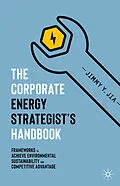Autorentext
Jimmy Y. Jia is Managing Partner of the Jia Group and an entrepreneur, author and strategist, who uses energy as an indicator of corporate governance and strategy. His approach helps corporations right-size consumption, thereby reducing waste. In acting as a virtual Chief Utility Officer," executives improve deployment of capital towards climate-resilient infrastructure, saving money, reducing exposure to volatile pricing and improving competitive advantage.
He sits on the boards of the Center for Sustainable Energy and the CleanTech Alliance, is an Adjunct Professor at Presidio Graduate School and a Visiting Scholar at George Washington University. He graduated from MIT and Oxford.
Inhalt
Chapter 1. Prologue: Why Create a Toolkit of Frameworks?
Part I. Energy-as-Strategy
Chapter 2. Introduction to Part I: What Is Energy-as-Strategy?
Chapter 3. Strategy Literacy: Seeking Competitive Advantage
Chapter 4. Energy Literacy: The Energy Balance for Business Decisions
Chapter 5. Financial Statements: The Universal Language of Business
Chapter 6. Energy Statements: Mediating Decision Cycles
Chapter 7. Carbon Strategies: De-risking Exposures
Part II. On System Properties
Chapter 8. Introduction to Part II: What Is a System?
Chapter 9. Systems Literacy: How to Think in Systems
Chapter 10. Metrics Systems: Managing Resource Flows
Chapter 11. How to Create Your Own Framework
Part III. On Leadership
Chapter 12. Introduction to Part III: What Is a Leader?Chapter 13. Organizational and Decision-Making Tools
Chapter 14. Communication: Using Structures to Send Information
Chapter 15. Communication: Perceiving Structure When Receiving Information
Part IV. On Innovation
Chapter 16. Introduction to Part IV: What Is Innovation?
Chapter 17. How to Ask Questions
Chapter 18. Micro-Innovations: Incremental Process Improvements
Chapter 19. Meso-Innovations: Creating Serendipity for Emergent Ideas
Chapter 20. Macro-Innovations: The Discipline of Scaling Adoption
Part V. Non-Financial Indicators for Corporate Governance
Chapter 21. Introduction to Part V: What Is Governance?
Chapter 22. Influence of Energy on Internal Reporting
Chapter 23. External ESG Reporting Frameworks
Part VI. Epilogue
Chapter 24. Epilogue: Advice to an Energy Strategist
